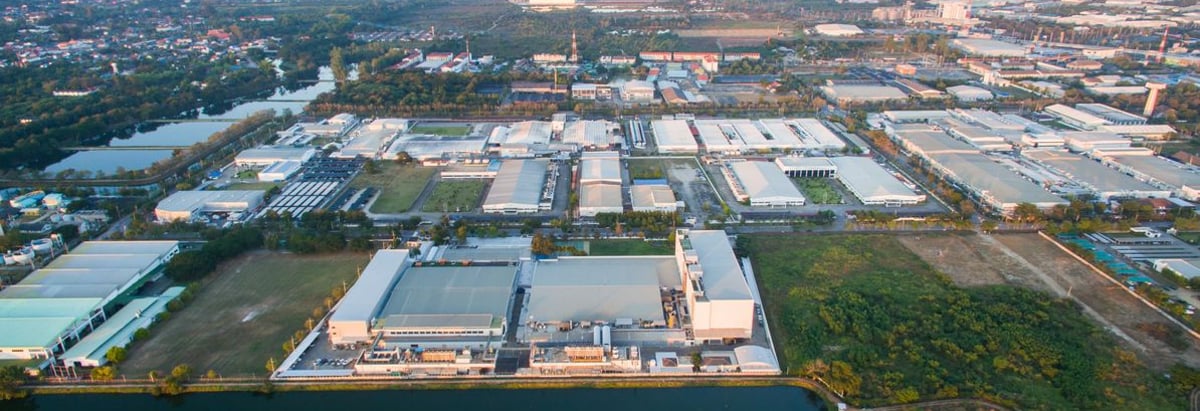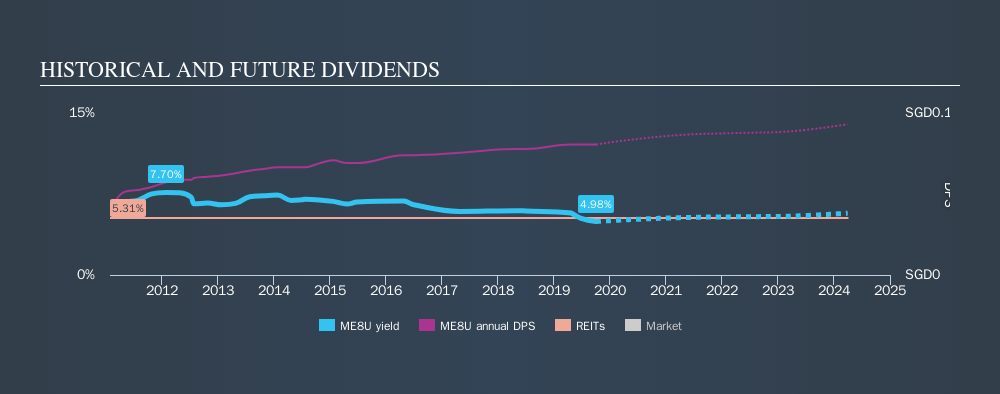- Singapore
- /
- Industrial REITs
- /
- SGX:ME8U
Are Dividend Investors Getting More Than They Bargained For With Mapletree Industrial Trust's (SGX:ME8U) Dividend?

Today we'll take a closer look at Mapletree Industrial Trust (SGX:ME8U) from a dividend investor's perspective. Owning a strong business and reinvesting the dividends is widely seen as an attractive way of growing your wealth. Unfortunately, it's common for investors to be enticed in by the seemingly attractive yield, and lose money when the company has to cut its dividend payments.
With a goodly-sized dividend yield despite a relatively short payment history, investors might be wondering if Mapletree Industrial Trust is a new dividend aristocrat in the making. It sure looks interesting on these metrics - but there's always more to the story . There are a few simple ways to reduce the risks of buying Mapletree Industrial Trust for its dividend, and we'll go through these below.
Explore this interactive chart for our latest analysis on Mapletree Industrial Trust!

Payout ratios
Dividends are typically paid from company earnings. If a company pays more in dividends than it earned, then the dividend might become unsustainable - hardly an ideal situation. Comparing dividend payments to a company's net profit after tax is a simple way of reality-checking whether a dividend is sustainable. Mapletree Industrial Trust paid out 68% of its profit as dividends, over the trailing twelve month period. A payout ratio above 50% generally implies a business is reaching maturity, although it is still possible to reinvest in the business or increase the dividend over time.
Another important check we do is to see if the free cash flow generated is sufficient to pay the dividend. Mapletree Industrial Trust paid out 68% of its free cash flow last year, which is acceptable, but is starting to limit the amount of earnings that can be reinvested into the business. It's encouraging to see that the dividend is covered by both profit and cash flow. This generally suggests the dividend is sustainable, as long as earnings don't drop precipitously.
REITs like Mapletree Industrial Trust often have different rules governing their distributions, so a higher payout ratio on its own is not unusual.
Is Mapletree Industrial Trust's Balance Sheet Risky?
As Mapletree Industrial Trust has a meaningful amount of debt, we need to check its balance sheet to see if the company might have debt risks. A quick check of its financial situation can be done with two ratios: net debt divided by EBITDA (earnings before interest, tax, depreciation and amortisation), and net interest cover. Net debt to EBITDA is a measure of a company's total debt. Net interest cover measures the ability to meet interest payments. Essentially we check that a) the company does not have too much debt, and b) that it can afford to pay the interest. Mapletree Industrial Trust has net debt of 5.12 times its EBITDA, which implies meaningful risk if interest rates rise of earnings decline.
Net interest cover can be calculated by dividing earnings before interest and tax (EBIT) by the company's net interest expense. Mapletree Industrial Trust has EBIT of 6.81 times its interest expense, which we think is adequate. Despite a decent level of interest cover, shareholders should remain cautious about the high level of net debt. Rising rates or tighter debt markets have a nasty habit of making fools of highly-indebted dividend stocks. That said, Mapletree Industrial Trust is in the real estate business, which is typically able to sustain much higher levels of debt, relative to other industries.
Dividend Volatility
One of the major risks of relying on dividend income, is the potential for a company to struggle financially and cut its dividend. Not only is your income cut, but the value of your investment declines as well - nasty. The first recorded dividend for Mapletree Industrial Trust, in the last decade, was nine years ago. Its dividend has not fluctuated much that time, which we like, but we're conscious that the company might not yet have a track record of maintaining dividends in all economic conditions. During the past nine-year period, the first annual payment was S$0.061 in 2010, compared to S$0.12 last year. This works out to be a compound annual growth rate (CAGR) of approximately 8.0% a year over that time.
Mapletree Industrial Trust has been growing its dividend at a decent rate, and the payments have been stable despite the short payment history. This is a positive start.
Dividend Growth Potential
Dividend payments have been consistent over the past few years, but we should always check if earnings per share (EPS) are growing, as this will help maintain the purchasing power of the dividend. It's not great to see that Mapletree Industrial Trust's have fallen at approximately 5.4% over the past five years. Declining earnings per share over a number of years is not a great sign for the dividend investor. Without some improvement, this does not bode well for the long term value of a company's dividend.
We'd also point out that Mapletree Industrial Trust issued a meaningful number of new shares in the past year. Regularly issuing new shares can be detrimental - it's hard to grow dividends per share when new shares are regularly being created.
Conclusion
When we look at a dividend stock, we need to form a judgement on whether the dividend will grow, if the company is able to maintain it in a wide range of economic circumstances, and if the dividend payout is sustainable. First, we think Mapletree Industrial Trust is paying out an acceptable percentage of its cashflow and profit. Second, earnings per share have been in decline, and the dividend history is shorter than we'd like. With this information in mind, we think Mapletree Industrial Trust may not be an ideal dividend stock.
Without at least some growth in earnings per share over time, the dividend will eventually come under pressure either from costs or inflation. Businesses can change though, and we think it would make sense to see what analysts are forecasting for the company.
If you are a dividend investor, you might also want to look at our curated list of dividend stocks yielding above 3%.
We aim to bring you long-term focused research analysis driven by fundamental data. Note that our analysis may not factor in the latest price-sensitive company announcements or qualitative material.
If you spot an error that warrants correction, please contact the editor at editorial-team@simplywallst.com. This article by Simply Wall St is general in nature. It does not constitute a recommendation to buy or sell any stock, and does not take account of your objectives, or your financial situation. Simply Wall St has no position in the stocks mentioned. Thank you for reading.
About SGX:ME8U
Mapletree Industrial Trust
A real estate investment trust (“REIT”) listed on the Main Board of Singapore Exchange.
6 star dividend payer and good value.
Similar Companies
Market Insights
Community Narratives





